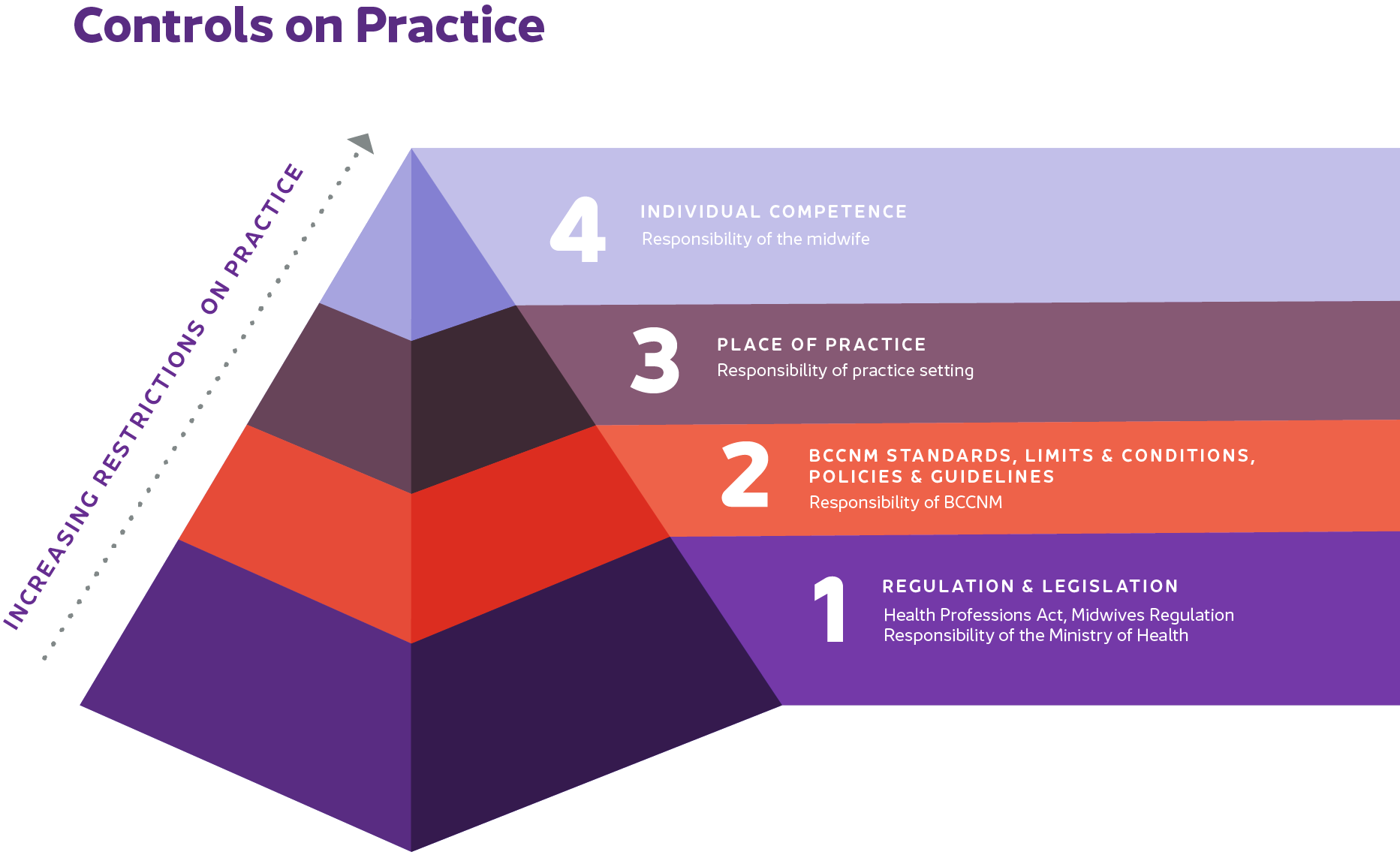In B.C., the
Midwives Regulation sets out midwives' scope of practice. The Midwifery Regulation defines midwifery as the health profession in which a person provides midwifery services during normal pregnancy, labour, delivery, and the postpartum period.
Scope of practice refers to the activities that registered midwives are educated, competent, and authorized to perform.
There are two aspects of midwifery scope:
1. Midwifery profession's scope of practice
This includes:
2. Individual midwife's scope of practice
A midwife's individual scope of practice is shaped by their unique background and practice setting. Each midwife's individual practice will look different. Midwives individual scope of practice within their practice settings is influenced by:
- Their education
- Authority to perform activities
- Their individual competence, i.e., the ability to integrate and apply knowledge, skills, attitudes, and judgment for safe and appropriate performance in practice
- Policies that may restrict a midwife's practice in a practice setting (e.g., clinic, hospital, or home)
Controls on practice is a framework that helps define a midwife's scope of practice. It can be used as a decision support tool to help you understand what activities are in scope, when you can perform them, what limits or conditions must be met, and what competencies are required.
There are four levels of regulatory control on a midwife's practice. Each level, from the top to the bottom, works to narrow and define a midwife's scope of practice.

1. Legislation & regulation
The
Health Professions Act and the Midwives Regulation broadly outline the activities midwives are authorized to perform.
For example, the Midwives Regulation sets out that midwives provide health-care services to clients during “normal pregnancy, labour, delivery and the postpartum period." Therefore, under the Regulation, a midwife is not authorized to provide care to clients who fall outside this requirement (e.g., treating a client's non-pregnant partner).
Guiding questions to help understand how regulation defines your practice:
- How does the activity fit within the legal definition of midwifery as per the Midwives Regulation?
- Does the care involve restricted activities? Are these activities within the Midwives Regulation?
- Is the activity authorized in the Midwives Regulation to my registration class?
- What other provincial or federal legislation may be relevant to my practice (e.g.,
Freedom of Information and Protection of Privacy Act)?
2. BCCNM
BCCNM bylaws, standards, limits, and conditions further define the scope of practice set out in the Regulation.
For example, before prescribing narcotics, a midwife must complete the BCCNM-approved course as set out in the Medications and Substances: Standard, Limits, Conditions. A midwife is not authorized to prescribe narcotics if the course is not successfully completed.
Guiding questions to help understand how BCCNM further defines your practice:
- What specific BCCNM standards, limits & conditions, policies, and guidelines relate to this activity?
- Is it in the clients' best interest for me to provide this care?
3. Place of practice
"Place of practice" can be defined as the location in which midwives provide care to clients (e.g., a clinic, hospital in which you have privileges, or independent practice setting). Practising midwives are required to know which activities they are authorized to perform in their place of practice as these policies may restrict or define the practice of midwives in a particular location.
For example, some hospital policies may restrict midwives from performing an activity like water births, even if midwives have the skills and knowledge to perform it or have performed it at another place of practice.
Guiding questions to help understand how place of practice policies define your practice:
- Do the place of practice policies authorize me to perform the activity?
- Do my privileges include the activity to be performed?
- Are there resources to support me before, during, and after the activity?
4. Individual competence
Competence is the integration and application of the professional attributes (knowledge, skills, attitudes, and judgment) required to perform in a given role, situation, or practice setting. An individual midwife's competence to carry out a particular activity may further define a midwife's scope.
An individual midwife determines whether they have the necessary competence to safely perform an activity for their client and whether they can appropriately manage the outcomes of care in their practice setting. If a midwife has not acquired the competence to perform an activity, they have a duty not to perform it. For example, if a midwife is not sure they can safely perform an amniotomy because they haven't recently performed this procedure, they should not proceed with it even though amniotomy falls within midwives' legal scope of practice.
Guiding questions to under stand how individual competence defines your practice:
- Do I have the competence to carry out the activity safely and appropriately? (i.e., Do I have the knowledge, skills, and judgment to: assess the appropriateness of performing the activity; perform the activity; and manage the client before, during, and after the activity?)
- How will I gain and maintain my competence?
- Can I meet the relevant BCCNM standards of practice, policies, and guidelines and place of practice policy requirements related to this activity?
Am I the most appropriate care provider?
- If required, do I have the additional practice certification needed to perform the activity?